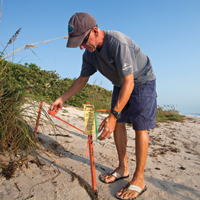 Irene shrinks beaches, claims sea turtle nests
Irene shrinks beaches, claims sea turtle nests
STORY BY EILEEN KELLEY, (Week of September 1, 2011)
What two weeks ago was a fairly flat summer beach for most our barrier island was cut in about half in places when Hurricane Irene tracked up the Atlantic coast before making landfall in North Carolina. That wasn’t good for the sea turtles.
Rick Herren, an environmental specialist with Indian River County and the sea turtle coordinator for the southern half of the county’s beaches, surveyed the local impact of Irene last weekend, and found that turtle nests didn’t fare too well as strong winds and high surf chopped away portions of the beach and pulled thousands of turtle eggs into the sea.
Some dunes in the beach renourishment area also took a beating, officials said.
Herren, a biologist for two decades, said about 11 per cent of the all sea turtle nests – both those empty from earlier hatchings and those still incubating the eggs – were destroyed by the storm.
One marker – No. 803 – used to rise about three feet from the sand. On Saturday, only the top 18 inches were visible after the storm’s 10-foot waves shifted the sand.
The lack of visible nests – the staked off areas that dot the beach landscape here from March through the end of October – stood out to biologist like Herren and regular beachcombers like Barbara Tilney.
“What happened to all the nests?” asked Tilney as she walked over to Herren at the Beachcomber Lane entrance to the beach.
Tilney routinely walks the beach. In a small stretch just a week ago, Tilney said there were close to a dozen marked nests. After Irene, there was just one.
For Herren’s half of the county, the marked nests represent only about 10 per cent of all the nests along the beach. As of late August there were 2,267 nests. Hatchlings have emerged from about 60 per cent of those nests already. Each nest is home to about 100 to 130 eggs.
The nests closest to the dunes stood the best chance of surviving the storm, but about half of the nests built in what was the center of the beach were washed away.
Tinley doesn’t like to hear that so nests many were destroyed.
“This is a natural order of things,” said Herren. “Hurricanes are part of the environment in Florida.”
So is development along the coastline which has impacted the natural order of the tides and beaches and led to extensive, multi-million-dollar beach renourishment programs to retain sand and control erosion.
Vero Beach is in the midst of such program on a 6.6 mile swath of the beach along the island’s northern shore. The plan calls for dumping 586,000 cubic yards of sand along the area. About 80 per cent of the work has been completed.
James Gray, the county’s coastal engineer, said it was difficult to say how much of an impact Irene had on erosion. He said the island did better than anticipated and any sand that may have been washed away in the renourishment project likely washed up elsewhere along the beach.
“The beaches fared pretty well,” Gray said.








